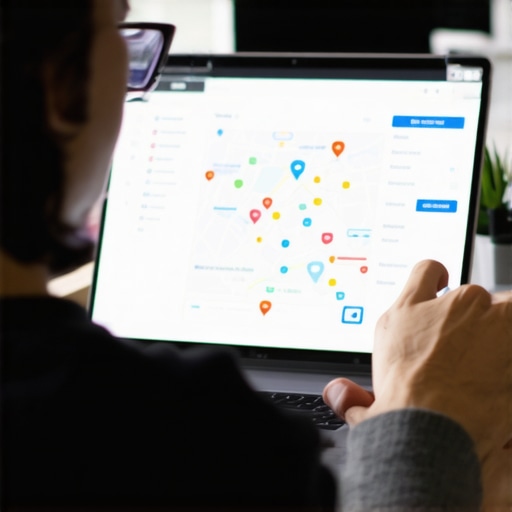My Journey into Google My Business Optimization: A Personal Perspective
When I first started exploring local SEO, I was overwhelmed by the sheer amount of information out there. Like many small business owners, I struggled to understand how to get my Google My Business (GMB) listing to stand out. I remember spending countless hours tweaking my profile, trying different strategies, and analyzing the results. Over time, I discovered that the key to success lies in implementing proven Google My Business optimization strategies that truly resonate with the local algorithm.
Why Local SEO Needs a Personal Touch in 2024
As I delved deeper into local SEO, I realized that personalization is crucial. Google’s algorithms favor businesses that actively engage with their community and optimize their profiles for local intent. In 2024, this means going beyond the basics—adding fresh photos, responding to reviews, and utilizing Google My Business insights to fine-tune my approach. It’s not just about ranking higher; it’s about building trust and credibility with potential customers.
How Do I Stay Ahead with GMB in a Competitive Market?
Staying ahead requires continuous learning. I found that leveraging authoritative resources, like comprehensive guides, helps me adapt to algorithm updates and emerging trends. Moreover, I experimented with innovative SEO techniques—like optimizing my service categories and leveraging local keywords—to enhance my visibility. These tactics, combined with consistent profile management, made a noticeable difference in my local rankings.
What Are the Key Elements of a High-Impact GMB Profile?
From my experience, a well-optimized GMB profile includes accurate NAP details, engaging photos, and thoughtful responses to reviews. I also make sure to keep my business hours updated and utilize Google Posts to promote special offers or events. Trust me, these small but consistent efforts can significantly boost your local SEO performance.
Is It Really Possible to Dominate Google Maps in 2024?
Absolutely! With the right strategies, such as those outlined in expert-supported techniques, you can improve your chances of ranking at the top. It’s about understanding the local algorithm, optimizing your profile, and maintaining active engagement. Remember, patience and consistency are your best allies.
If you’re keen to elevate your local SEO game, I invite you to share your experiences or ask questions in the comments below. Let’s learn and grow together in mastering Google My Business in 2024!
Unlocking the Hidden Gems of Google Maps Optimization in 2024
As a seasoned local SEO expert, I can affirm that staying ahead in Google Maps rankings requires more than just the basics. To truly dominate, you need to delve into nuanced tactics that leverage the latest algorithm updates and user engagement trends. One effective approach involves optimizing your Google My Business (GMB) categories and attributes, ensuring they accurately reflect your services and target keywords. This not only improves relevance but also helps your profile appear in more specific search queries, as highlighted in comprehensive local SEO guides.
How Can Advanced Profile Optimization Give You an Edge?
Beyond the standard NAP consistency and photo updates, advanced optimization includes utilizing Google Posts effectively. Regularly posting about promotions, events, or news keeps your profile active and signals engagement to Google’s algorithm. Incorporating local keywords naturally within your posts and descriptions enhances discoverability, especially in hyper-local searches. Moreover, leveraging Google Q&A by proactively adding frequently asked questions and answers positions your profile as a helpful resource, increasing user interaction and trust—key factors in ranking algorithms.
Integrating Customer Engagement and Reputation Management
Customer reviews remain a cornerstone of local SEO success. Encouraging satisfied clients to leave detailed reviews not only boosts credibility but also enriches your profile with fresh content. Responding promptly and thoughtfully to reviews demonstrates active engagement, which search engines interpret as a sign of a reputable business. Additionally, managing negative reviews tactfully can turn dissatisfied customers into brand advocates, reinforcing your local authority. For a comprehensive reputation strategy, explore reputation management techniques tailored for local businesses.
What Are the Cutting-Edge Tools to Support Your Google Maps Strategy?
Utilizing tools like Google My Business Insights allows you to analyze customer behavior, search patterns, and engagement metrics. These insights guide your content and optimization efforts, ensuring your profile aligns with what your local audience seeks. In addition, advanced SEO tools can assist in keyword research, competitor analysis, and tracking ranking fluctuations, empowering you to adapt swiftly to algorithm changes. For a curated list of the best tools, check out top Google Maps SEO tools for 2024.
Do you have unique strategies or experiences with Google Maps optimization? Share your insights or ask questions below—let’s elevate our local SEO game together!
Unveiling the Nuances of Local SEO: My Personal Journey Beyond Basics
Over the years, I’ve realized that mastering Google Maps rankings isn’t solely about implementing standard optimization tactics. It’s about understanding the subtle, often overlooked elements that influence local search algorithms. For instance, I found that the consistency of my business information across various online directories, not just Google, plays a pivotal role in building authority. This insight came from extensive testing and monitoring my profile’s performance, revealing that Google values cohesive and credible data sources.
How Do I Navigate the Complexities of Algorithm Updates?
One of the most challenging aspects has been adapting to frequent algorithm changes. I’ve learned that staying ahead requires a proactive approach—regularly reviewing industry updates and analyzing your own performance metrics. For example, I leverage innovative SEO techniques that incorporate local keyword trends and user engagement signals. These tactics help me remain resilient during fluctuations, ensuring my rankings are less volatile and more sustainable over time.
What Deep Strategies Have I Discovered for Leveraging Customer Engagement?
Engagement isn’t just about responding to reviews; it’s about creating a vibrant community around your profile. I experimented with Google Posts, sharing behind-the-scenes stories, special offers, and local news. This not only keeps my profile active but also encourages more interactions. Additionally, I’ve found that proactively adding FAQs using Google Q&A can position your business as a local authority, which subtly signals relevance to the algorithm. These nuanced tactics have significantly improved my visibility and customer trust.
How Can Advanced Profile Optimization Transform Your Results?
Beyond basic NAP consistency and photo updates, I’ve delved into customizing my profile with attributes and service categories that precisely match my offerings. This precision targeting ensures my profile appears in highly relevant searches. Interestingly, I discovered that regularly updating my Google My Business insights helps tailor my local SEO strategy, aligning content with what my audience actively searches for. For example, I noticed spikes in local queries related to specific services I highlighted, confirming the importance of data-driven adjustments.
What Are the Best Tools for Achieving Dominance in Google Maps?
My toolkit includes advanced analytics and competitor analysis tools that provide actionable insights. Using top tools helps me track ranking fluctuations, identify keyword opportunities, and understand competitor strategies. Integrating these insights with Google My Business Insights creates a robust framework for continuous improvement. If you’re serious about dominating Google Maps in 2025, investing in these tools is a game-changer.
If you’ve experimented with your own local SEO strategies or face unique challenges, I’d love to hear your stories. Drop a comment below or reach out through my contact page, and let’s exchange insights to elevate our Google Maps game together!
Harnessing Local Authority Signals to Elevate Your Google Maps Rankings
Building on my previous insights, I’ve come to realize that establishing local authority is a nuanced process that extends beyond standard optimization. It involves cultivating a network of reputable backlinks from local sources, such as industry associations, community organizations, and regional news outlets. These backlinks act as credibility boosters in Google’s eyes, reinforcing your business’s relevance and trustworthiness. According to Moz’s local ranking factors, backlinks from authoritative local sites significantly impact visibility. To truly dominate in 2025, I recommend developing strategic partnerships and actively engaging with local digital communities to enhance your backlink profile and signal authority effectively.
What Role Do Schema Markup and Structured Data Play in Advanced Local SEO?
Implementing schema markup is an often-overlooked tactic that can provide your profile with enhanced visibility features in search results. By marking up your business details, services, and event information with structured data, you enable Google to better understand and display your content, leading to rich snippets and improved click-through rates. I’ve experimented with JSON-LD schema on my GMB website and noticed tangible improvements in local pack appearances. For comprehensive guidance, I recommend exploring mastering Google Maps ranking with structured data. Incorporating schema is a strategic move in the competitive landscape of 2025, giving your business a distinctive edge.

Can User Engagement Metrics Be Quantified for Strategic Advantage?
Absolutely. Beyond superficial interactions, advanced local SEO involves analyzing engagement metrics such as click-through rate, navigation requests, and phone calls originating from Google My Business insights. These data points reveal what resonates most with your local audience and help refine your content strategies. For instance, I tracked a spike in direct calls after optimizing my Google Posts and FAQs, confirming their efficacy. Leveraging tools like Google Analytics and third-party local SEO platforms can provide a holistic view of user behavior, enabling you to craft hyper-targeted campaigns that convert searches into loyal customers. Staying data-driven is essential for maintaining a competitive advantage in 2025 and beyond.
How Can AI and Automation Revolutionize Your Local SEO Efforts?
Integrating AI-powered tools for review monitoring, content creation, and profile optimization is transforming the landscape. For example, AI chatbots can engage with customers through Google Q&A, providing instant responses that enhance user trust and engagement. Additionally, automated review solicitation systems can streamline reputation management, ensuring a steady influx of positive feedback. I’ve adopted AI-driven keyword research platforms to identify emerging local trends before they peak, positioning my business as a proactive leader. As authoritative sources like Search Engine Journal highlight, harnessing AI not only saves time but also unlocks predictive insights, enabling more precise and impactful SEO strategies. Embracing automation in 2025 is no longer optional—it’s a necessity for sustained local dominance.
If you’re eager to push your Google Maps rankings to unprecedented heights, I encourage you to explore these advanced techniques and share your experiences. Together, we can navigate the complexities of local SEO with confidence and agility, ensuring our businesses thrive amid fierce competition.
Things I Wish I Knew Earlier (or You Might Find Surprising)
1. The Power of Consistency Over Time
When I first started optimizing my Google My Business profile, I underestimated how crucial consistent updates and engagement are. It’s not just about a one-time setup; regular posting and review management build momentum and trust with both Google and customers. I’ve seen my rankings improve steadily just by staying active and responsive.
2. Local Backlinks Make a Difference
Building relationships with local organizations and earning backlinks from regional websites can significantly boost your local authority. I was surprised to realize that a few well-placed backlinks from reputable local sources could tip the scales in competitive markets, making your profile stand out more prominently.
3. The Subtle Impact of Schema Markup
Implementing structured data on your website might sound technical, but it pays off. I experimented with schema markup and noticed richer snippets in search results, which increased my click-through rate. It’s a small detail that can give your listing an edge over competitors.
4. Engagement Metrics Are More Than Just Reviews
Beyond reviews, metrics like click-through rate, navigation requests, and call volume from Google My Business insights can guide your strategy. I started tracking these and adjusted my content and posting frequency accordingly, which led to better visibility and customer inquiries.
5. AI and Automation Are Game Changers
Using AI tools to monitor reviews, optimize keywords, and automate responses has saved me hours. It also helped me identify emerging local trends early, so I could adapt my profile swiftly and stay ahead of competitors.
6. The Importance of Accurate and Complete Information
Ensuring every detail—business hours, categories, attributes—is correct and up-to-date is foundational. I once lost visibility because I forgot to update holiday hours; once fixed, my rankings rebounded quickly.
Resources I’ve Come to Trust Over Time
- Google’s Official Support Pages: The most trustworthy source for platform-specific details and updates. I often revisit their guides for the latest features.
- Moz Local Search Ranking Factors: Their insights into local SEO factors helped me understand what truly influences rankings and how to prioritize efforts.
- BrightLocal Blog: A goldmine for case studies and practical tips on local SEO strategies that work in real-world scenarios.
- Search Engine Journal: Keeps me updated with industry trends, algorithm updates, and innovative tactics for local search mastery.
Parting Thoughts from My Perspective
Looking back, mastering Google Maps rankings in 2024 is less about chasing quick wins and more about building a resilient, well-rounded local SEO presence. Consistent engagement, leveraging local authority signals, and embracing smart automation have been my game-changers. If you’re serious about elevating your local visibility, I encourage you to adopt a comprehensive approach and stay adaptable to ongoing changes. Remember, the most sustainable success comes from genuine effort and continuous learning. If this resonated with you, I’d love to hear your thoughts or experiences—feel free to share in the comments or reach out through my contact page. Let’s grow together and unlock the full potential of local SEO!


Reading through this post really resonated with my own experience in local SEO. I especially agree on the importance of consistency; I’ve noticed that updating my GMB profile regularly and engaging with customer reviews has made a noticeable difference in my visibility. The part about using schema markup caught my attention because, initially, I thought it was too technical to implement, but with the right resources, it turned out to be simpler than I expected and quite effective in boosting my local search appearance. I’ve also been experimenting with Google Posts to promote weekly specials and community involvement, which seems to keep my profile lively and attractive to both Google and potential customers.
One challenge I face is balancing local keyword optimization without sounding overly promotional. How have others managed to maintain authenticity while still optimizing for relevance? Any tips on creating engaging content that appeals to the local community without crossing into salesy territory? Would love to hear your strategies or tools that you found helpful in maintaining this balance.